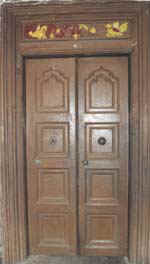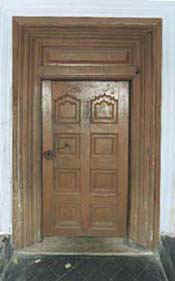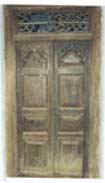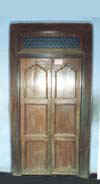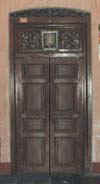 |
 |
|||||||||||||||||||||||||||||||||||||||||||||||||||||||
|
Traditional Entrances and Decoration - 2
Although we do not have any building survived as examples from the period of Jaffna kingdom, it can be safely assumed that simillar concept as discussed in the previous chapter would have been followed in those days in connection with the decoration of entrances. Fall of the Kingdom of Jaffna in 1620 A.D to the Portuguese forces, was the prelude to a 175 yeas long period of the suppression of Hindu relegion. In a period when public display of anything related to Hindu relegion met with punishment, the Hindu relegious art would have completely ceased to exist. During this period the concept of decoration at the entrances would have changed to reflect the new situation. Although we do not have many buildings from this period to study these changes, some of the existing examples of early 20th centuary give a few clues regarding the changes that would have taken place in the Portuguese and Dutch colonial periods.
Fig:2 shows a door that in all aspects simillar to the doors which were discussed earlier in the last chapter, but without the "sedippalakai" decoration. In the above example the "sedippalakai" had been replaced by a plain panel. A similar design would have been the logical and easy option for conforming to the newly evolved political situation. Subsequently many new ideas had been brought in as part of the new thinking process based on western culture and ideals. There are examples of doors with fret work panels decorated with floral patterns, glass panes , fanlights (Fig:3) etc. These types at various times became trends or standards and had been used repeatedly within a particular period of time.
These were partly due to the changing attitutes and requirements related to ventilation and lighting. This was the time when windows were introduced in Jaffna houses and were treated to match the door design. However this process had removed the element of symbolism as part of the permanent decoration from the main entrances. A revival of the Hindu artistic endevours were possible only around the last decade of the 18th century with the support from Tamilnadu. Building of several new temples around this time could have atracted many artisans, including wood carvers, Sthapatis etc., towards Jaffna and they would have contributed in the building of Traditional court yard houses in Jaffna.
|
|||||||||||||||||||||||||||||||||||||||||||||||||||||||
| Last updated on 02 February 2005 | ||||||||||||||||||||||||||||||||||||||||||||||||||||||||
YOUR VISITOR NO. TO THIS SITE IS  THANK YOU. THANK YOU. |
||||||||||||||||||||||||||||||||||||||||||||||||||||||||
